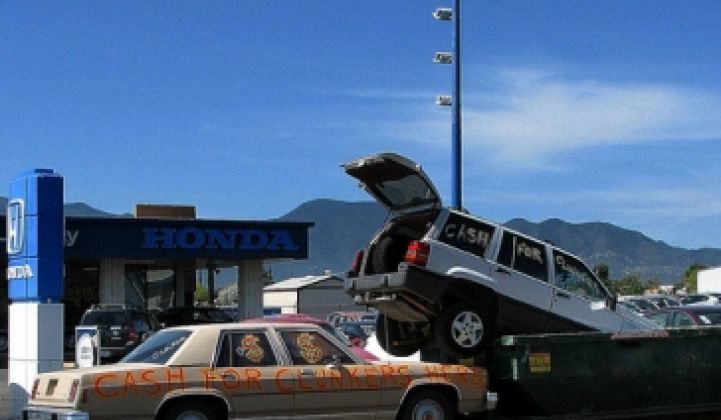Who would have thought that a program that involved putting thousands of dollars into the hands of U.S. consumers would have been a big hit? Apparently, Congress didn't. It under-budgeted the Cash for Clunkers program and now wants to re-fund it with money raided from the Department of Energy's loan guarantee program. The House of Representatives already passed the motion and the Senate is expected to vote on it before its summer recess begins this weekend.
Politically, the move would be brilliant. Most American taxpayers have no idea what a loan guarantee is or does. And who isn't perfectly happy to be handed a few thousand dollars in free government money? But it would be disastrous financial management on the part of our legislators.
The loan guarantee program is, in effect, the single most effective method of stimulating economic activity with the least cost to the government. The American Recovery and Reinvestment Act (ARRA) provided for $6 billion to provide loan guarantees for renewable energy and grid upgrade projects. But that doesn't just result in $6 billion in spending. The money pays for "credit subsidies." A credit subsidy is very similar to a loan loss reserve, which banks set aside for their loan portfolio. The money is a form of insurance in case some projects fail. In other words, for a $1 billion loan, the government will set aside $100 million (taken from the $6 billion kitty) into the credit subsidy pool in case the project developers default. Commercial banking loan loss reserves are typically set in the 3 percent to 5 percent range, but most observers expect a loan guarantee program to establish a 6 percent to 10 percent ratio for renewable energy projects to be guaranteed – taking into account their higher-risk nature.
What's especially beautiful about the loan guarantee program is that it fires a single bullet into the heart of the beast that's preying on the economy: the freeze in lending. That problem is hitting the renewable energy sector especially hard in that banks simply aren't lending for anything that smells remotely risky. By co-signing on the loan, the government drastically reduces the risk of the loan and therefore makes it palatable to the bank officers. Assuming that the project doesn't default during the course of the loan, the only financial penalty the government suffers is a slight reduction to its creditworthiness. But that's one of the most valuable weapons it can yield in the ongoing battle to stimulate the economy.
Another way of looking at the two government incentives is this: $2 billion in the Cash for Clunkers program results in $2 billion worth of economic activity, all of which will occur in a sector where the majority of the goods being sold are built in a foreign country; $2 billion in loan guarantees will result in at least $20 billion worth of economic activity, all of which will have to take place on U.S. soil.
And that might even be underestimating things. According to research done by IDC Energy Insights, the actual impact of $1 in credit subsidies might result in as much as $28 in project spending. That's assuming that 40 percent of the overall cost of the project is paid for with equity and the credit subsidy rate is set at 6 percent. Thus, in a best-case scenario, the $6 billion in credit subsidies will result in $168 billion in economic activity.
Taking $2 billion out of the loan guarantee credit subsidy pool will not completely decimate the program. It has already set aside about $4 billion for credit subsidies for renewable energy and transmission projects. However, taking away the remaining $2 billion will reduce the program's efficacy and scope during a time when the renewable energy industry is struggling to squeeze through the credit crisis.
The Cash for Clunkers program, however, can be said to have already achieved its aims. An estimated 250,000 pollution-heavy cars and trucks were taken off the roads and replaced with brand new vehicles, the majority of which appear to be fuel sippers. Ford announced earlier today that its July sales were up by 2.3 percent when compared to July 2008. Subaru likewise forecast that its final sales for the month will show a 34 percent increase over its July 2008 sales. General Motors and Chrysler each saw a decline in year-over-year sales, but reported large increases when compared to June 2009. In other words, the program did what it was supposed to do: It took a quarter of a million clunkers off the roads and spurred sales at showrooms across the country. If Congress feels that more such stimulus is needed, it can certainly wait until September, when both houses of Congress reconvene, to pass a sequel bill. And hopefully it can find some way to pay for it other than to raid a program that is very efficient at stimulating economic activity throughout the country.
Sam Jaffe is a senior research analyst in renewable and distributed energy for IDC Energy Insights. IDC Energy Insights is a research and advisory firm with clients in the utilities industry. Jaffe can be reached at [email protected].
Image courtesy Flickr / Creative Commons



